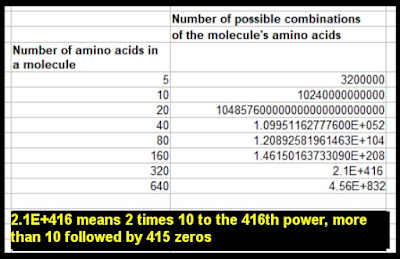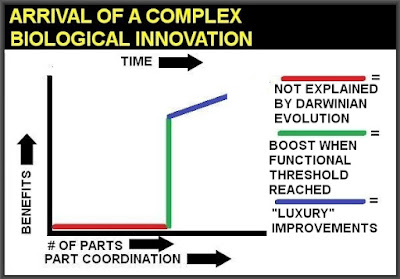The web site The Conversation (www.theconversation.com) has a "Science and Technology" tab where we often are given very bad explanations for things. A particularly witless example was a recent article entitled "What really drives anti-abortion beliefs? Research suggests it’s a matter of sexual strategies." We were then given one of the many very silly work products of evolutionary psychology, something with a long history of providing groundless speculative explanations given a little scientific flavoring by some sprinkling of Darwinist verbiage. The speculation given (centered around the groundless idea that "sexually restricted people benefit from increasing the costs of sex") has no basis in either observation, logic or evolutionary theory.
Another "bad explanation" article on The Conversation site attempts to address why people are skeptical of some claims of scientists. We read no mention of things such as the replication crisis, that an apparent majority of findings in scientific papers fail attempts to experimentally replicate them. Instead we read this:
"How can scientists increase their credibility? ... To increase trustworthiness, they can convey that their work is motivated by selfless goals."
This claim is very funny. Scientists work for salaries. The more papers they publish, and the more such papers are read and cited, the higher is the chance that a scientist will move up some career path that may lead from being a mere "reader" or adjunct professor or assistant professor to being a better-paid full professor with tenure. The ultimate career goal of a scientist is to become a famous professor, who makes lots of money by writing books that are widely read. The work of scientists is not mainly motivated by selfless goals.
By contrast, consider a person such as myself. All of my blogs are free for anyone to read. I also have various books that you can access from my site www.markmahin.com or by using the link here. All of the books on those two pages can be read online for free. I have a Creative Commons license on all of my blogs, under which anyone can reproduce any of my posts for free, on any web site they have or any book they are publishing. I have never made a penny from my blogging or photographic activities, and a few occasional dollars I get from them is canceled out by my photographic expenses, which have been in excess of $2000. I take no contributions, and get no ad revenue. So when you read any of my posts, you can be sure that what I was writing or photographing was in no way motivated by money.
Another "bad explanation" article on The Conversation website attempts to answer a different question. The article has this long title: "Game of Thrones star Emilia Clarke is missing ‘quite a bit’ of her brain. How can people survive and thrive after brain injury?" We read that the talented actress Emilia Clarke had surgery removing significant portions of her brain, which occurred before she filmed most of the years of work she did on that show.
This is not at all the most dramatic example of people functioning well despite major loss of brain tissue. Other more dramatic examples include:
(1) Many cases of epilepsy patients who were suffering from seizures so bad that they had half of their brains surgically removed, in an operation called a hemispherectomy.
(2) Some split-brain patients who had their epilepsy treated by severing the fibers (called the corpus callosum) that connects the two hemispheres of the brain.
(3) Many patients who lost the great majority of their brain tissue through diseases such as hydrocephalus, which slowly converts brain tissue to watery fluid.
Contrary to claims that the mind is produced by the brain and that memories are stored in the brain, such massive loss of brain tissue often produces little change in memory or mental capacity. My post "Preservation of Mind and Memories After Removal of Half a Brain" (which you can read here) describes cases in which removing half of a brain had no major effect on either mind or memory. For example, here is a quote from the American Journal of Psychology, Vol. 46, No. 3 (Jul., 1934), pages 500-503, regarding work by a physician named Dandy:
"Dandy has completely removed the right cerebral hemisphere from eight patients....Later examinations showed no observable mental changes. The patients were perfectly oriented in respect of time, place, and person; their memory was unimpaired for immediate and remote events; conversation was always coherent; ability to read, write, compute, and learn new material was unaltered. Current events were followed with normal interest. There were no personality changes apparent; the patients were emotionally stable, without fears, delusions, hallucinations, expansive ideas or obsessions, and with a good sense of humor; they joked frequently. They showed a natural interest in their condition and future. They cooperated intelligently at all times throughout post-operative care and subsequent testing of function."
Let's look at whether either of these explanations is a strong one.
Poor Explanation #1: Neural Plasticity
To explain the phrase "neural plasticity" I should first start by explaining the simpler term "synaptic plasticity." The term "synaptic plasticity" has long been used by those who claim that memories are stored in synapses. It has often been claimed that when a memory is created, some synapses kind of mold themselves to store the memory. Those advancing this claim would sometimes claim that synapses are molded by experience or sensory experience rather as some clay can be molded by an artist.
There has never been any robust evidence to support such claims. Instead of having evidence for memory formation by synaptic plasticity, we merely have evidence for constant remodeling and physical turnover in synapses. All synapses can be very roughly compared to the wet sand at the edge of the seashore, which is constantly remodeled by the action of the tides. What often goes on in neuroscience studies is that after some animal learns something, a neuroscientist will look at some synapses, and see some evidence of change. The neuroscientist will often claim that the change resulted from the learning that occurred. The fallacy in such work is that all synapses in the brain are constantly changing, regardless of whether anything is learned. So the mere observation of a change in some synapses does nothing to show that such change occurred because of something that an organism learned.
The constant remodeling of synapses occurs largely because of the short lifetimes of synapse proteins. Synapses are made of proteins that have average lifetimes of two weeks or less. Such short lifetimes make an extremely strong reason for disbelieving claims that memories are stored in synapses. Human memories often last 1000 times longer than the average lifetime of synapse proteins. But despite the lack of good evidence for claims that memories are stored in synapses, neuroscientists love to use the vague term "synaptic plasticity." The type of evidence cited for synaptic plasticity is usually just evidence for synaptic instability all over the brain.
The term "neural plasticity" is a term similar to the term "synaptic plasticity." Neural plasticity is some alleged ability of the brain to rewire itself. Connections between brain cells are constantly being built and broken down, just as vines between trees are constantly being built and decaying in the dense regions of the Amazon rain forest.
However, there is no evidence that brains can rebuild themselves the way the liver can. A page at the NIH describes that ability of the liver:
"The liver has a unique capacity among organs to regenerate itself after damage. A liver can regrow to a normal size even after up to 90% of it has been removed."
But the brain has no such ability to regenerate itself. If you take out a part of the brain, it remains lost. When half of the brain is removed in a hemispherectomy operation to stop very bad seizures, the brain does not regenerate the missing half. When a quarter or an eighth of the brain is removed to get rid of a cancerous tumor, the brain does not grow back the missing part.
Professor Hannan makes this misleading claim: "The key to understanding how brains can recover from trauma is that they are fantastically plastic – meaning our body’s supercomputer can reshape and remodel itself." The brain is not a computer, and the brain lacks seven characteristics of information-storage devices such as computers, as I point out in my post "Seven Things in Fast Retrieval Systems, None of Which Your Brain Has." There is no evidence that brains reshape themselves or remodel themselves in any way that can explain the preservation of mental abilities after loss of large parts of the brain. Evidence typically given for neural plasticity or synaptic plasticity should really be described instead as evidence for mental resiliency, the ability of the mind to keep functioning well despite brain damage.
Much of what Professor Hannan says to back up his claims are unproven and easy-to-discredit claims about brains storing memories. He provides no evidence at all that the brain generates very many more synapses or neurons to make up for synapses or neurons that were lost. About the best that he can do is to make this claim (which he does not support with specifics):
"With brain injury, the changes can be bigger; you get certain rewiring around the injury. These synapses can rearrange themselves to work around the damaged part."
Poor Explanation #2: Neurogenesis
The second thing Professor Hannan attempts to do to explain well-functioning minds after massive brain damage is to appeal to what he calls neurogenesis: the ability of a brain to make new brain cells. He says this:
"But there’s another form of plasticity called neurogenesis. This involves little pockets in the brain where new neurons continue to be born throughout life. And there’s evidence that after brain injury these neural stem cells can be stimulated and migrate to the area of injury and make new neurons."
Unfortunately, the evidence for adult neurogenesis is very weak. Attempts to observe neurogenesis produce conflicting results. Many neuroscientists believe that human adults do not generate new brain cells in significant numbers. Even those who argue for neurogenesis claim numbers of new neurons through neurogenesis so low that they cannot appreciably explain the persistence of human mental abilities despite massive loss of brain tissue.
A 2019 paper says this about adult neurogenesis (the formation of new neurons):
"Here we examine the evidence for adult human neurogenesis and note important limitations of the methodologies used to study it. A balanced review of the literature and evaluation of the data indicate that adult neurogenesis in human brain is improbable. In fact, in several high quality recent studies in adult human brain, unlike in adult brains of other species, neurogenesis was not detectable."
Below we see a recent paper with a title of "Mounting evidence suggests human adult neurogenesis is unlikely."









